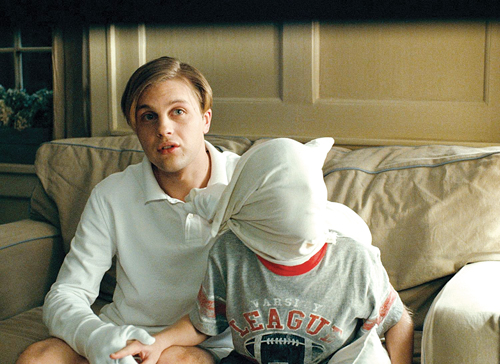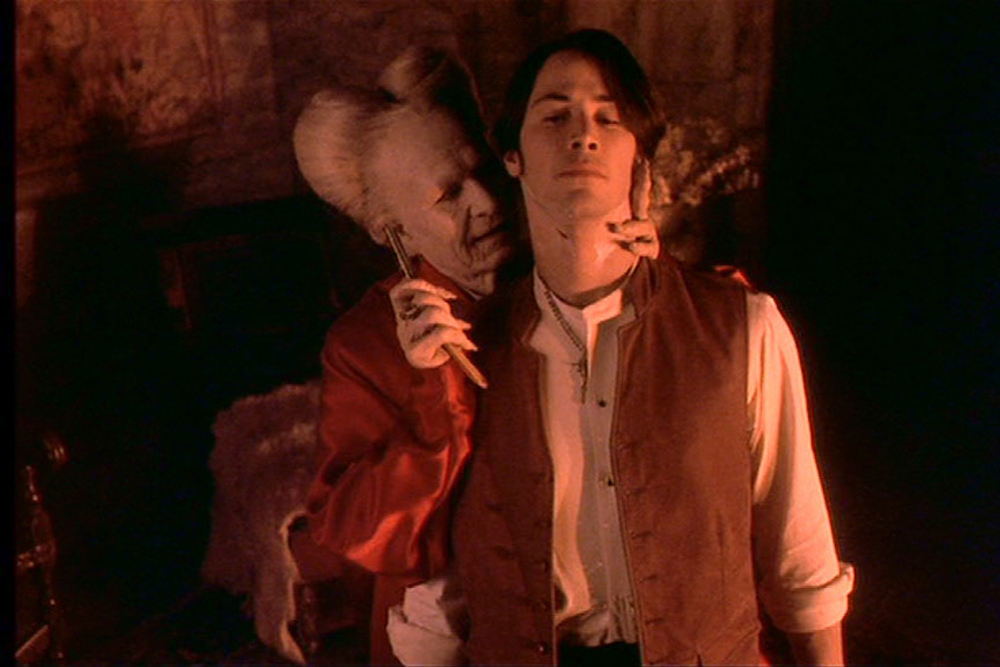To write about Funny Games is to give it away, but write I must. The name Michael Haneke may clue you in to the fact that what you are about to watch is neither straightforward nor simple.
Funny Games points the finger at us

To write about Funny Games is to give it away, but write I must. The name Michael Haneke may clue you in to the fact that what you are about to watch is neither straightforward nor simple.
If that name doesn’t ring a bell, then the rude interjection of John Zorn’s psychotic noise metal into the opening scene of bourgeois domestic harmony will dispel any expectations of normalcy.
The film is a meta-commentary on media violence. Media violence is terrible, and you, the viewer, are implicated in its promulgation.
When the dapper and psychotic yuppie Peter (Frank Giering) smashes Georg Schoeber’s (Ulrich Mühe) knee with a golf driver, the moment is so perfectly staged that the viewer imminently expects it and yet flinches at its sudden ferocity. The act mimics real-life violence: swift, harsh and impossible to prepare for.
A short while later, Peter plays his first “funny game” with Georg’s wife, Anna (Susanne Lothar). While Peter’s less attractive, less intelligent (but equally psychotic) sidekick, Paul (Arno Frisch), stands in the doorway guarding Georg and son, Georg, Peter plays the hot/cold game with Anna.
She attempts to find the family dog, which Peter has brained with the driver and stuffed into the family SUV. While Anna walks dumbly around the yard, Peter prompting her “cold, colder, freezing,” he turns to the camera and winks.
It’s a startling moment that lasts just long enough. The meaning of the gesture is at first obscure but then becomes clear: The antagonist is inviting the viewer to play along. Peter invites us media consumers to sympathize with him, the sadist.
Cheap Shots could have been an alternate title for this film. Hitting someone in the knee with a golf club is a cheap shot. The entire premise is a cheap shot. The driving force of terror and suspense is the overpowered patriarch, unable to protect his family. The bound mother helplessly watching her only child get abused. These tropes are as old as tragedy. Yet the film works.
It works because—despite the now-cliché disregard for the fourth wall and the zany, hyperbolic self-reference—the film is hard to watch. It’s truly terrifying. The idea of powerless protectors is indeed powerful, made more so by Haneke’s understated mise-en-scène and masterful cinematography.
Haneke’s camera is steady, unflinching. It moves matter-of-factly across the terrified family and their young abductors. And just as the killers do, it takes its precious time in exposing the bloodshed.
After the first murder, perhaps five minutes pass before the camera reveals anything except the paralyzed Anne, while the television ceaselessly drones an automobile race. When it does, it alights on the corpse casually, as if the lens was just passing by and happened to notice a bloody mess on the floor.
The film deals in cinematic clichés, but they seem fresh because they are so effective. Peter placidly prepares a sandwich as Paul counts down to execution in the other room (yet another cheap shot). He doesn’t pause or flinch when the gun goes off.
When Anna runs down the street, screaming for help, headlights in the distance are as likely the killers’ as they are a savior. Haneke uses these well-worn images to elucidate the primal nature of violence and fear. He illustrates that violence, like sex, is so fundamental that its cinematic depiction reliably evokes the same visceral response time and again. Horror and pornography are equally mechanical.
Hence, if Haneke intended to make a statement about the supposed desensitizing effect of violent media, then he failed miserably. If, however—and this seems more likely—he intended to portray how incredibly cheap and easy violent entertainment is, he still failed.
He failed because this isn’t just any film rehashing worn out horror clichés: This is a really well-made film rehashing worn out tropes and horror clichés. The acting is spotless. The lighting is superb. The suspense is laid as neatly as a white-linen-set table and drawn as tightly as a piano string. The soundscape is spare; the whimpers, moans, shouts and garbled pleadings ring out clear from unpolluted silence. There is verisimilitude to it all.
Haneke actually manages to breathe new life into the torture-horror genre, perhaps unintentionally. The reaction of the audience when Peter winks at the camera is not to roll the eyes but to stare with wide-eyed confusion.
We are forced to ask ourselves: This isn’t that kind of film, is it? This film is too nice for that. This film wouldn’t do that to me. There isn’t anything about the plot to suggest that this is a nice film. It’s simply about the way, with its neutral palette and masterful timing, that it looks.
Which is why, after all, Anna lets Paul into the house in the first place. He looks nice. He looks like a college student, a young Ivy Leaguer out to enjoy a weekend sailing.
Funny Games (1997)
Friday, May 11, 7 and 9:30 p.m.
Saturday, May 12, 7 and 9:30 p.m.
Sunday, May 13, 3 p.m.
Free for PSU students;
$2 other students and seniors;
$3 general admission






